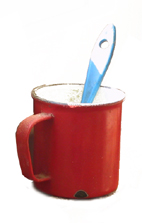The joints can also be designed to hold without glues or other additional reinforcements. A dowel-reinforced hole joint or a wedged tenon joint are good examples of this. Glue is very effective in wood joints when both joints have a grooved surface. A properly glued joint can be as strong or even stronger than the piece of wood itself. Glue is a much less effective attachment medium on smooth joints than on roughened ones. Generally, the stronger the joint, the larger the area on the parts to be joined that is applied with glue. The direction of the grains of the wood, the quality of the wood and the species characteristics must also be taken into particular consideration when designing a joint. A requirement for all structural adhesive joints is that a fracture must come from the wood, and not from a glued seam. The glue bond is thus stronger than the wood itself.
Dispersion glues are most commonly used for gluing wood joints. Their drying rate and moisture resistance have improved significantly to the present day. Epoxy and polyurethane glues are mainly used in outdoor furniture and in joints with oily wood, as well as in damp structures.
Wood gluing has evolved in many ways lately. Reliability has increased and costs have fallen. Curing times have been reduced from hours to minutes. Certain glues are filling and function well even if there are gaps in the glued surfaces. The pressures required for glue pressing have decreased by up to one tenth, compared to the previous products. In special adhesives, no pressing whatsoever is required.

Nowadays, for example, cross-gluing of preforms can already be performed on large pieces, such as in the manufacture of CLT boards and in modern log structures.
The bonding of wet wood has also become possible. Finger-jointed sawn timber is manufactured in such a way that the finger joint is made in wet wood and subsequent drying takes place afterwards.
Read more on gluing (link)